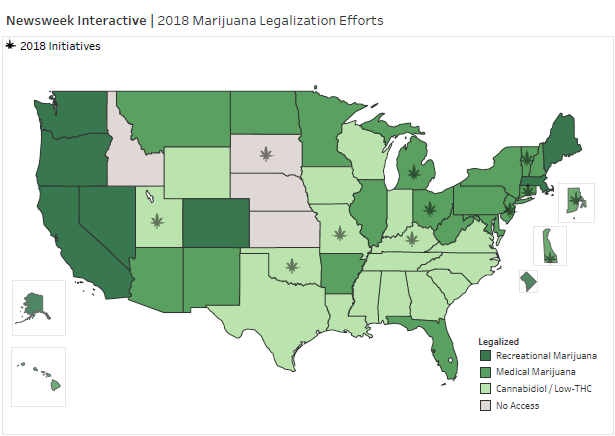Things happen fairly slowly, you know. They do. These waves of technology, you can see them way before they happen, and you just have to choose wisely which ones you’re going to surf. If you choose unwisely, then you can waste a lot of energy, but if you choose wisely, it actually unfolds fairly slowly. It takes years.
~~ Steve Jobs
The cannabis industry is already bigger than the two leading erectile dysfunction drugs Viagra, and Cialis – $20.4 and $24.4 billion markets in 2017 respectively. It is expected to grow 3 folds to $70 billion annually by 2021. Ace investors like Warren Buffett and Peter Thiel have already jumped into the game, and with it, the marijuana investment opportunities got increased by multifold. All this indicates that the race to become the ‘Apple’ of marijuana has begun.

Various small and mid-sized companies have been pro-actively filing patents to gain a strategic advantage after spotting the opportunity. It is high time that businesses involved in growing/developing cannabis-related products start patenting their invention – the earlier the better. This will provide them early mover’s advantage to capture the market share.
To help you understand what major companies are already doing to adapt to that change, what kind of products they are working on, what kind of startups are emerging, etc.. we also have a webinar lined up that you would definitely find useful. Here’s everything that we are going to share.
Since marijuana is still a Schedule- I drug in most of the states in the US, a common concern is can I filed a marijuana-related patent? Yes, you can because the USPTO has been issuing patents related to cannabis since 1942. This brings a little relief. However, there are a plethora of unanswered concerns and we picked a few of them.
Let’s discuss them one by one:
Patent Filing Activities in the Marijuana Domain
The most popular patent on Cannabis – US6630507, is filed by the US Govt. More than 1,500 patent applications have been filed at the USPTO even after it is being deemed illegal.
The marijuana domain, for a long time, witnessed a constant up and down in the patenting activity. This trend of late has started showing some positive sign after various state has started legalizing marijuana for medical as well as recreational uses.
It might be because of this reason on 4th August 2015 USPTO awarded Ecuadorian Sativa, a subsidiary of Cannabis Sativa, US9095554 – one of the first few patents for a cannabis plant with significant amounts of THC, which is otherwise rare to see.
The below excerpt from an article on Forbes shares take of David Cohen, Ph.D., an independent patent agent who works with medical device and cannabis patents, on can cannabis being patented, and also what type of patents are filed. Have a read:
“Yes, this is presently a small area of activity, but may also represent an opportunity. Plants can be patented in two ways, by way of “utility patents” (like 95% of all patents) or by way of a separate “plant patent” category. Utility patents are much stronger; plant patents are narrowly focused on a single “parent” plant and its direct descendants. By my count, there are currently only 5 US plant patent cases (4 pending applications, 1 issued patent), and 11 utility plant-directed patent cases (8 pending applications, 3 issued patents)…”
“Two companies are currently the main players in plants: the plant-focused Biotechnology Institute (Los Angeles CA) has 3 issued patents as well as 2 pending applications, and GW Pharmaceuticals (UK) has two plant-focused applications. GW is notable for having the largest cannabis-directed portfolio (80+ US cases) of all companies in the space, and is particularly focused on methods of treating diseases.”
As there are speculations of many states legalizing marijuana – more on it in the next section, the patent filing activity may increase by multifold in the coming months. Thus, it is now or never kind of situation for the small and mid-sized companies because once big fishes gear up, the barrier to entry for them may become too high. And for big players, it’s high time to gain an edge over the competition and be ahead in the game.
Cannabinoid Research and Development: What big companies are doing?
A sudden hike and fall in the patent filing activity of big conglomerates– food, agriculture, tobacco, pharma, etc.– over the years have been observed. Various stats show that their patent activity peaked in 2006-2007 and has been declining since then. Hence, their role, until now, was a bit skeptical.
There are speculations of big-name re-entering into the cannabis space. In the recent past, a number of big companies like Philip Morris have shown some positive trends towards the exploration of the marijuana domain. Philip Morris, in January 2016, invested $20 million in ‘Syqe Medical’, which has developed a metered inhaler to control doses of Cannabis. This inhaler allows medical cannabis to be delivered safely by turning it into granulate and allowing it to be taken in metered doses.
Other than this, PMI has acquired US9115366B2 – “System for producing terpenoids in plants”. This patent clearly mentions its application: the glandular trichomes found among others in the Solanaceae (tomato, tobacco, potato, pepper, eggplant, etc.), Asteraceae (sunflower, etc.) and Cannabaceae (e.g. Cannabis sativa) families.
Big conglomerates like Philip Morris are trying to get a first-mover advantage in the cannabis industry. A lot of big players may use the M&A route to enter into the domain. For SMEs and Startups, it’s the time to fence their niche areas before an organization with the capability to spend billions in R&D take over the charge.
What is the status of the legalization of Marijuana?
Several US states have allowed the use of marijuana not only medical but recreational use as well. Maine, Nevada, California, Massachusetts allows recreational use of marijuana. California joined the club on 1st Jan 2018 which considering its population is a significant development.
At this moment only 8 states allow recreational use of marijuana which is expected to increase to 18 by 2020. Further, there are speculations that by the end of 2018, at least 12 states can legalize marijuana. For more information on legalization landscape of marijuana, I suggest you visit this link: Marijuana Legalization: Defensive walls of countries are coming down

What Could Happen in the Marijuana Research Next?
Research activities from big players like Philip Morris have already started. Few other startups have also been active for some time. If one wants to have an early mover’s advantage, the time is now.
If you make your mind to explore the domain, you may like to know the biggest opportunities and pathways for the entry. Further, there are many other such IP related questions that need to be answered; for example:
- What markets are the most promising areas in the domain?
- What areas should you invest your time and money into?
- What are the white spaces in the domain for pharma/agriculture/food/tobacco companies? And which areas might be ripe for pursuing patents, or which are evidently too important to ignore, regardless of crowding in the area.
- What are the main sources of research in the field (Universities, Research Labs, Companies, or Individual Inventors, etc.)? Which companies, universities, etc. have been filing most number of patent applications and exploiting the technology domain? Who are the potential contenders for M&A?
We have answers to all these and some more. All we need to know is your area of interest here. So, which one concern piques your interest? Let’s discuss-
Authored By: Gaurav Sharma, Associate, IP Solutions
This article is a part of an ongoing series on the Marijuana domain. Below is the list of all the articles of the series:











